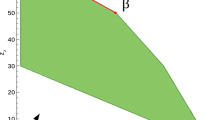Abstract
Reverse convex programs generally have disconnected feasible regions. Basic solutions are defined and properties of the latter and of the convex hull of the feasible region are derived. Solution procedures are discussed and a cutting plane algorithm is developed.
Similar content being viewed by others
References
M. Avriel and A. C. Williams, Complementary geometric programming,SIAM J. Appl. Math. 19, 125–141, 1970.
M. Avriel and A. C. Williams, An extension of geometric programming with applications in engineering optimization,J. Eng. Math. 5, 187–194, 1971.
E. Balas, Intersection cuts—a new type of cutting planes for integer programming,Operations Research 19, 19–39, 1971.
P. P. Bansal and S. E. Jacobsen, Characterization of local solutions for a class of nonconvex programs,J. Optimization Theory and Applications, Vol. 15, No. 5, May 1975.
P. P. Bansal and S. E. Jacobsen, An algorithm for optimizing network flow capacity under economies-of-scale,J. Optimization Theory and Applications, Vol. 15, No. 5, May 1975.
R. Carvajal-Moreno,minimization of Concave Functions Subject to Linear Constraints, Operations Research Center Report ORC72-3, University of California, Berkeley, 1972.
F. Glover and D. Klingman, Concave programming applied to a special class of 0–1 integer programs,Operations Research 21, 135–140, 1973.
F. John, Extremum Problems with Inequalities as Subsidiary Conditions, In:Studies and Essays: Courant Anniversary Volume, (eds.) K. O. Friedrichs, O. E. Neugebauer, J. J. Stoker, Interscience Publishers, New York, 1948.
R. J. Hillestad, Optimization problems subject to a budget constraint with economies of scale,Operations Research 23,No. 6, Nov–Dec. 1975.
J. E. Kelley, The cutting plane method for solving convex programs,J. SIAM 8, 703–712, 1960.
O. L. Mangasarian,Nonlinear Programming, McGraw-Hill, New York, 1969.
R. Meyer, The validity of a family of optimization methods,SIAM J. CONTROL 8, 41–54, 1970.
J. B. Rosen, Iterative solution of nonlinear optimal control problems,SIAM J. Control 4, 223–244, 1966.
J. Stoer and C. Witzgall,Convexity and Optimization in Finite Dimensions, Springer-Verlag, New York, 1970.
H. Tuy, Concave programming under linear constraints,Soviet Mathematics 5, 1437–1440, 1964.
U. Ueing, A combinatorial Method to Compute a Global Solution of Certain Non-Convex Optimization Problems, In:Numerical Methods for Non-Linear Optimization, (ed.) F. A. Lootsma, 223–230, Academic Press, 1972.
P. B. Zwart, Computational Aspects on the Use of Cutting Planes in Global Optimization, In:Proceedings of Association for Computing Machinery, 457–465, 1971.
Author information
Authors and Affiliations
Additional information
Communicated by J. Stoer
Research supported by NSF Grant ENG76-12250
Rights and permissions
About this article
Cite this article
Hillestad, R.J., Jacobsen, S.E. Reverse convex programming. Appl Math Optim 6, 63–78 (1980). https://doi.org/10.1007/BF01442883
Received:
Issue Date:
DOI: https://doi.org/10.1007/BF01442883




